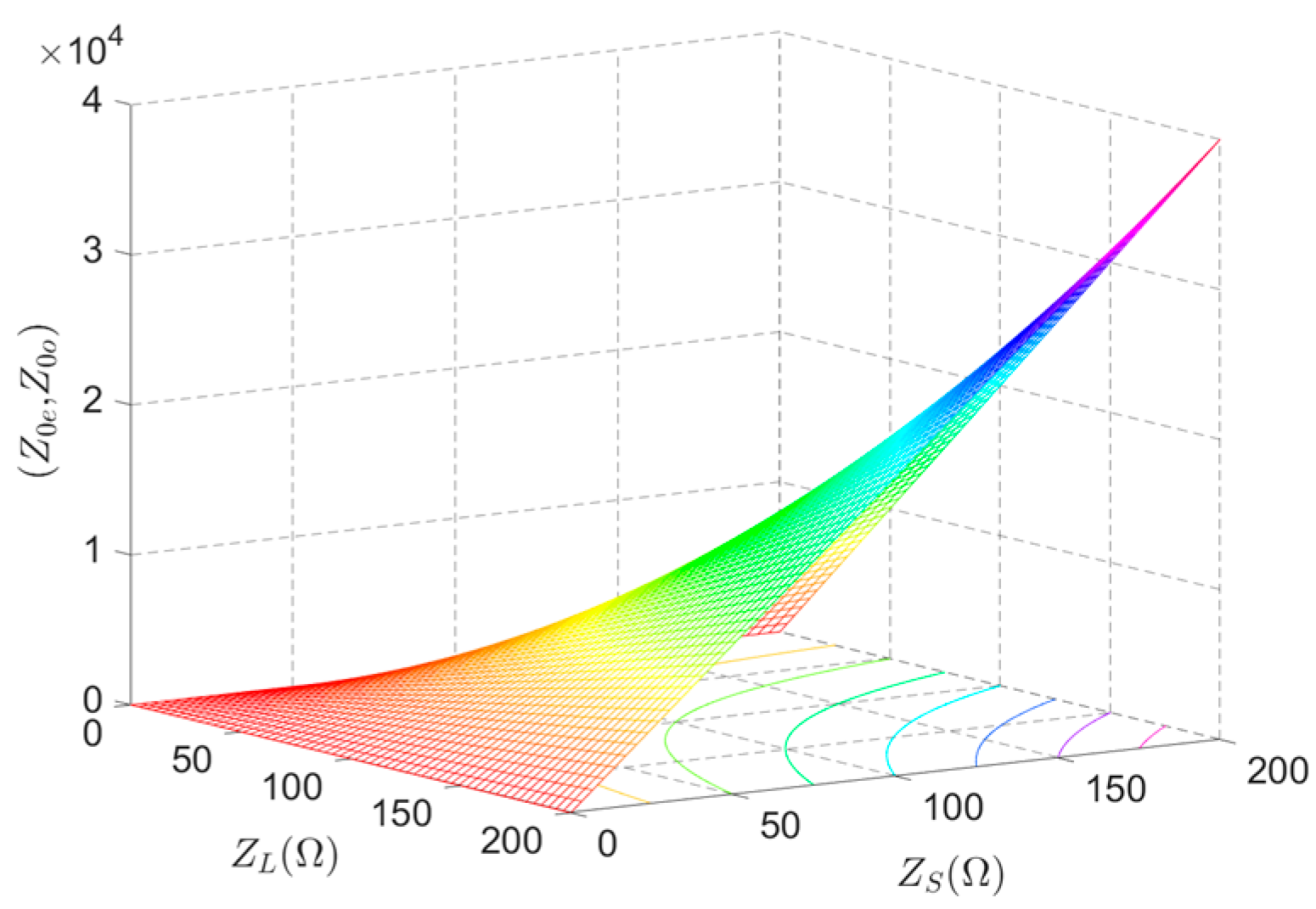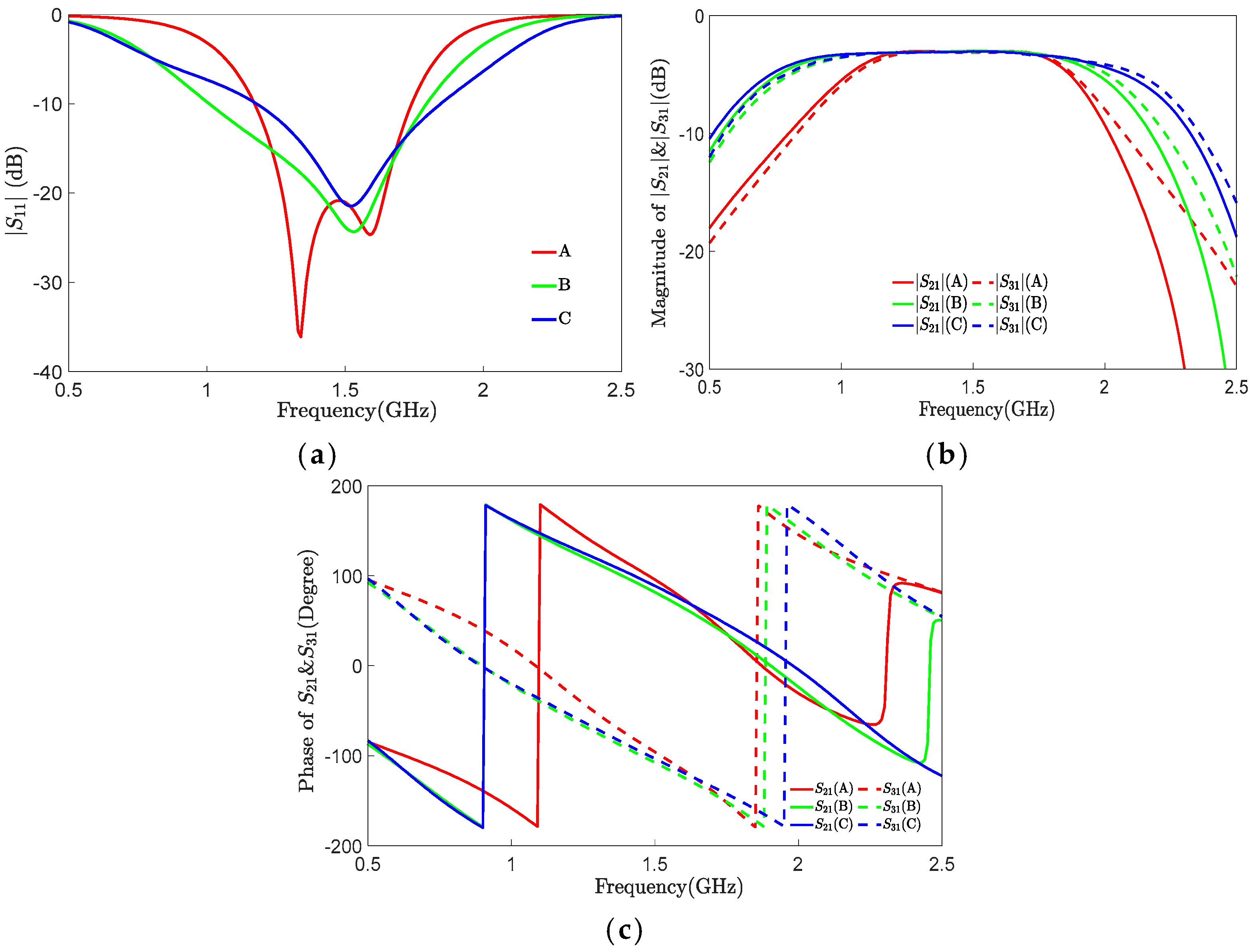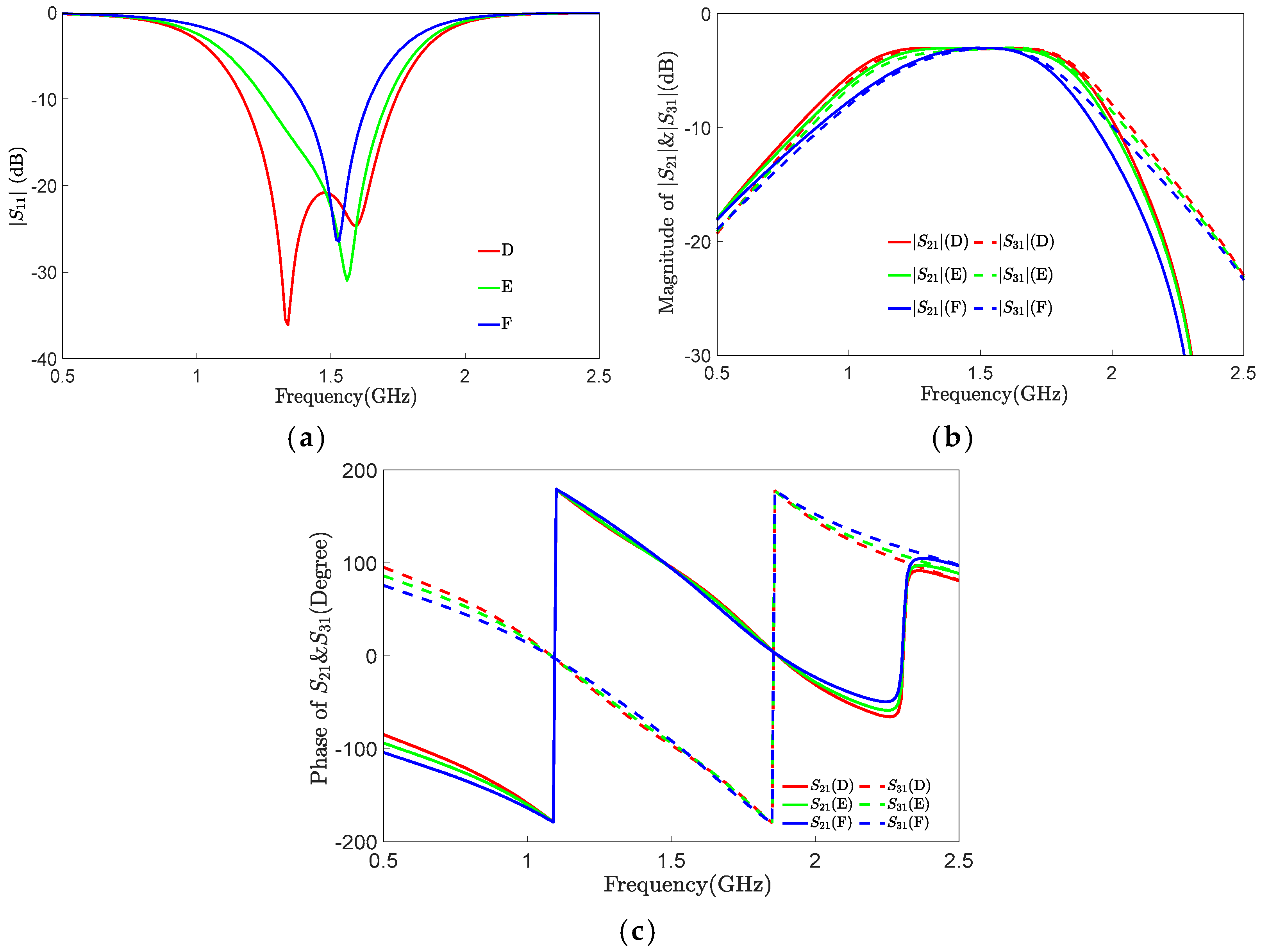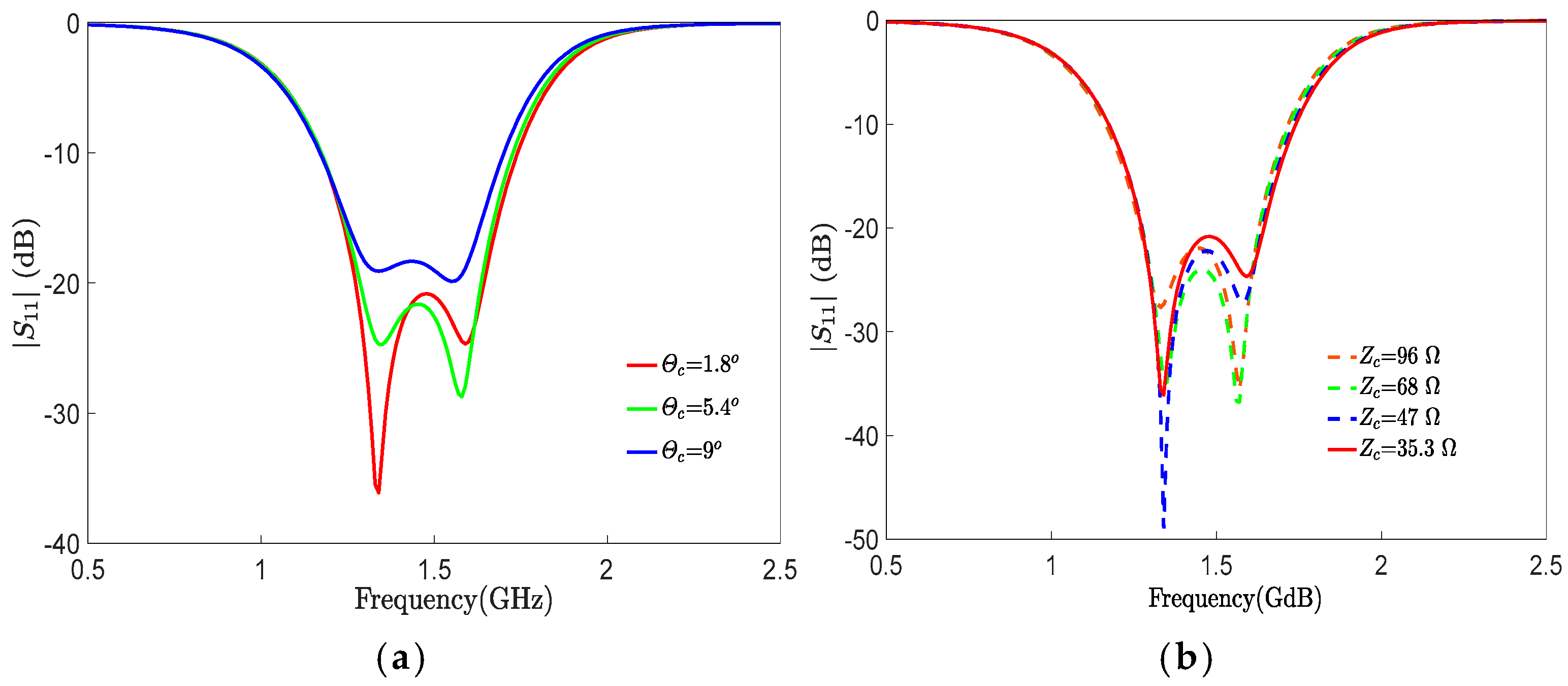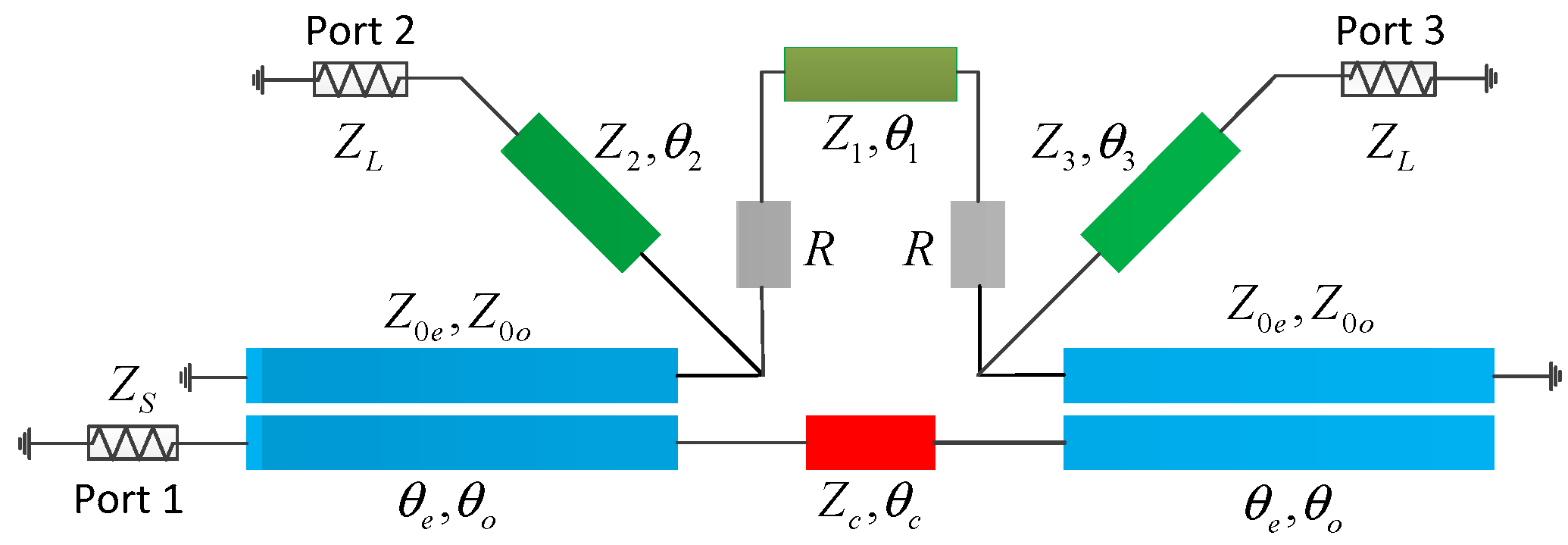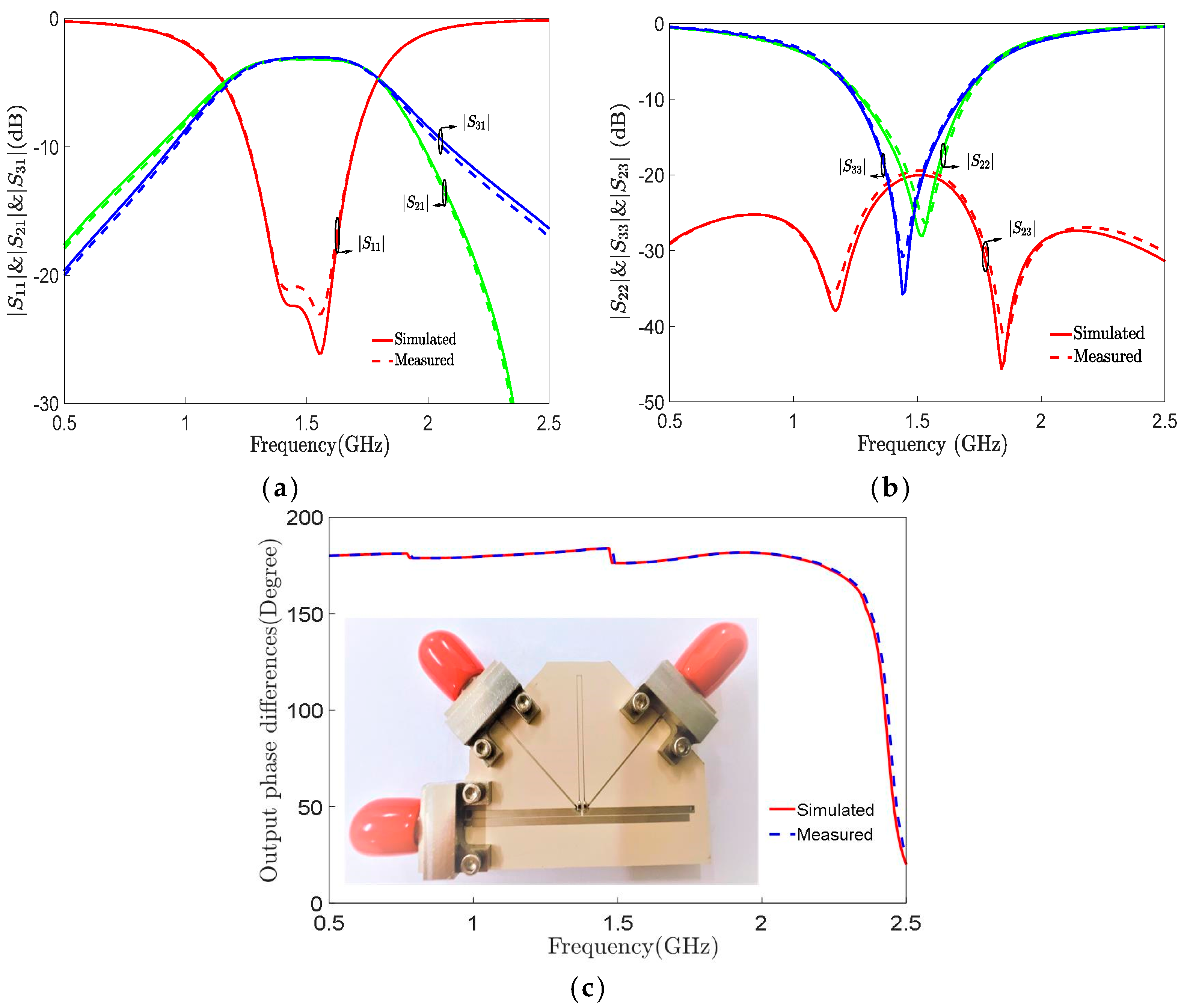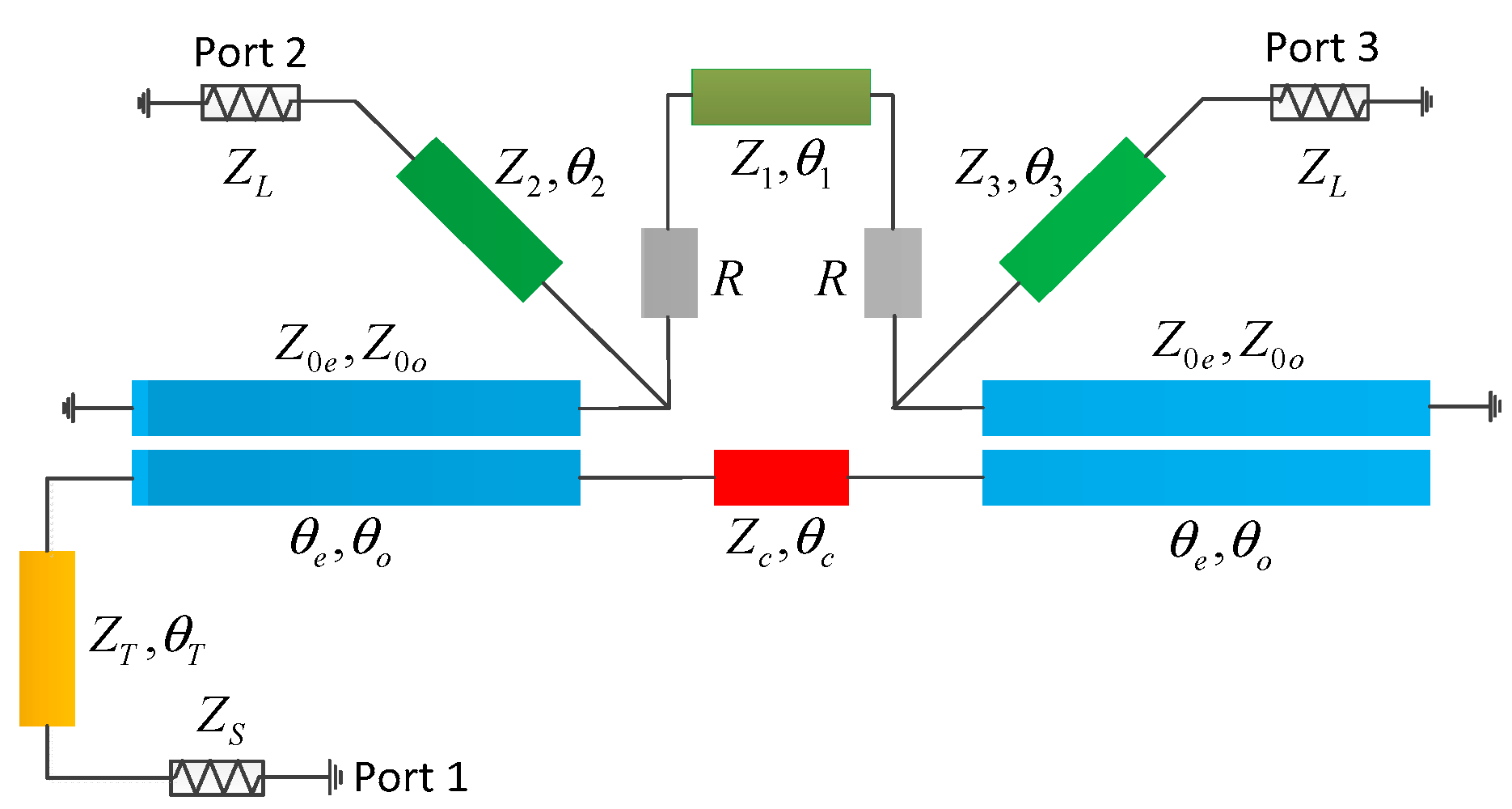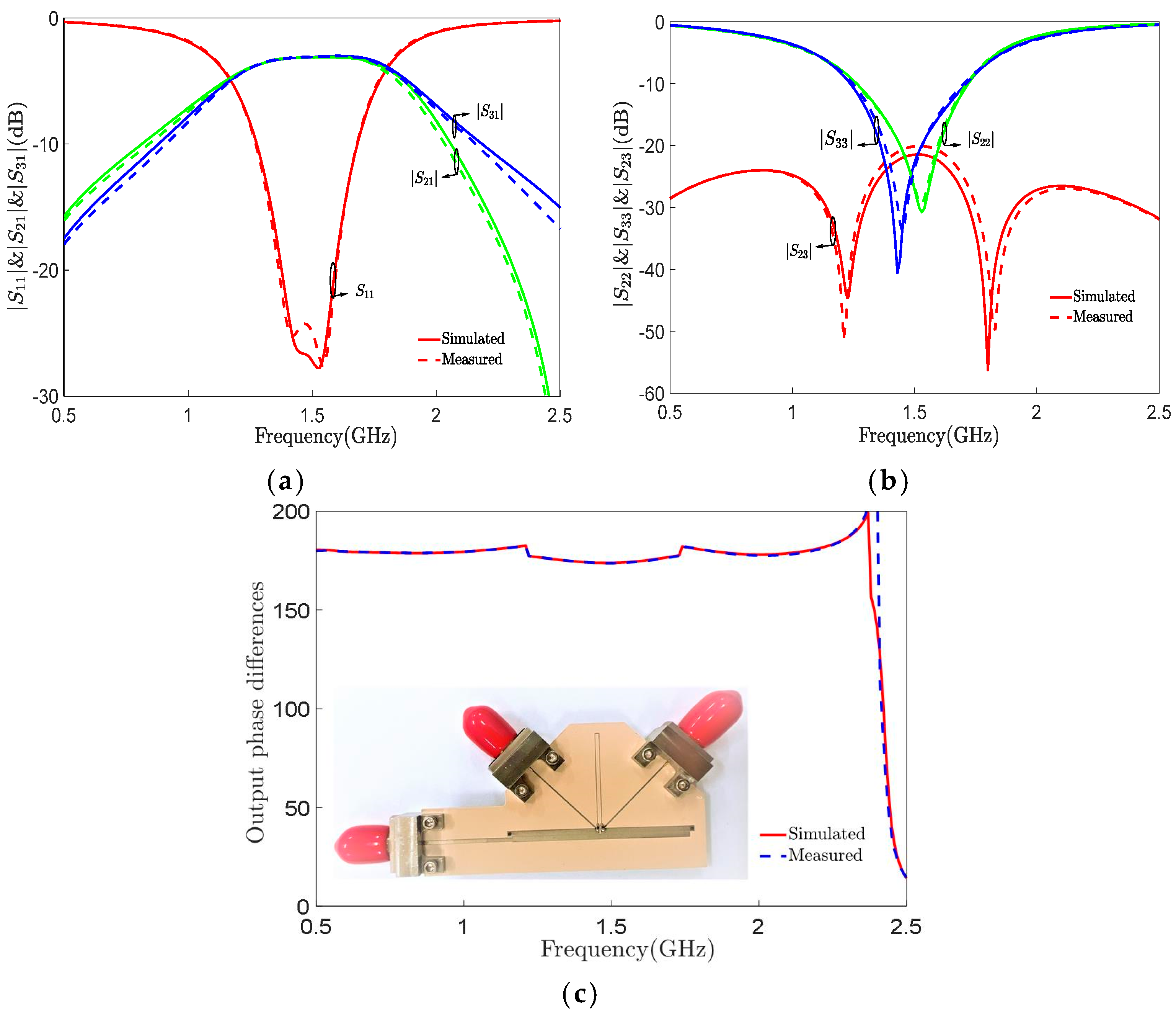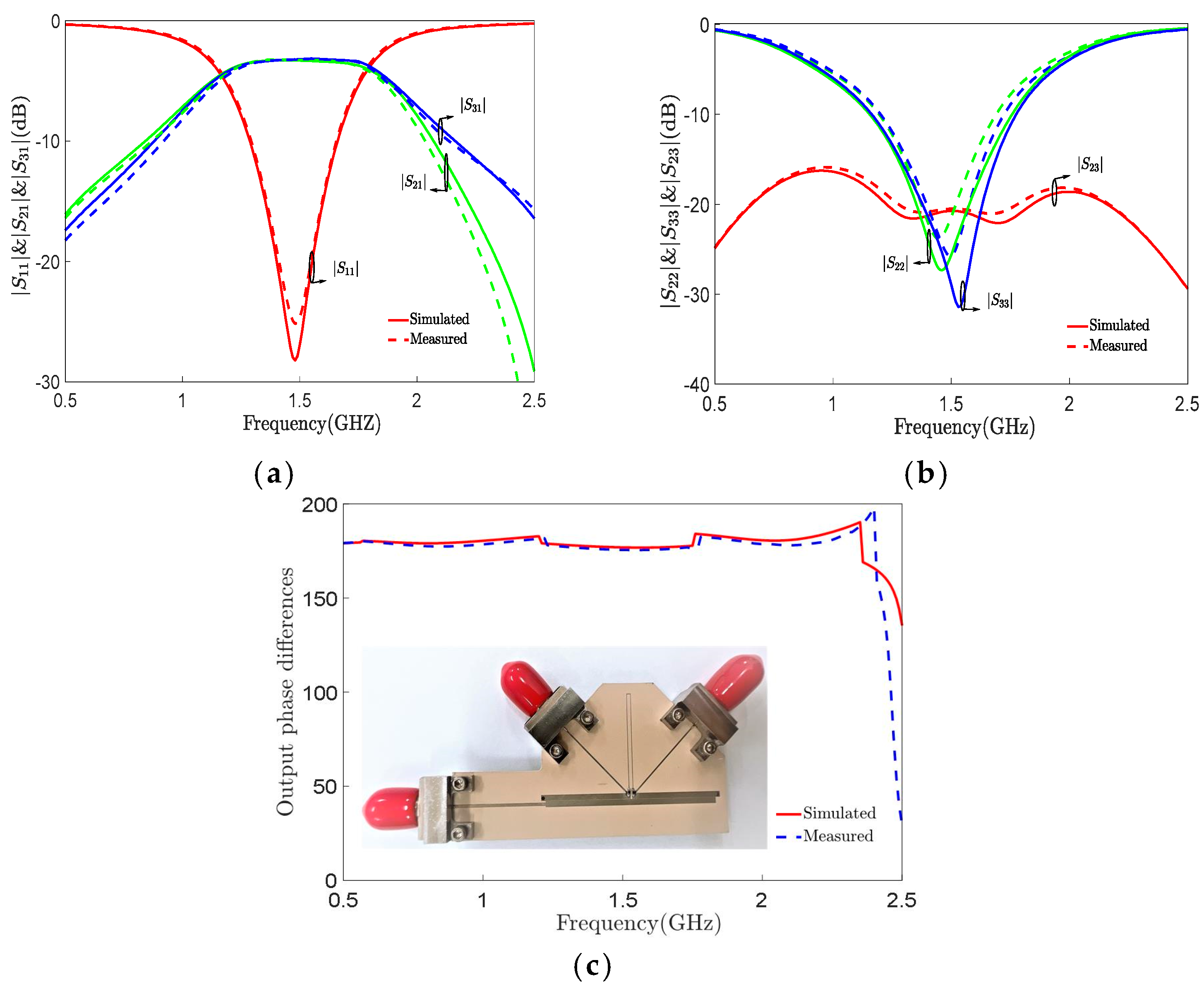1. Introduction
A balun is an indispensable component in circuits and systems involving balanced and unbalanced signals, and baluns are widely applied in balun power division filters [
1], low-noise power amplifiers [
2,
3], balanced mixers [
4], frequency multipliers [
5], and dipole antenna feeds [
6,
7]. Depending on the operating frequency and applications, various technologies can be exploited to implement baluns, such as low-temperature cofired ceramic technology [
8], CMOS technology [
9], active devices [
10], lumped elements [
11,
12,
13], transmission lines [
14,
15,
16,
17,
18,
19,
20,
21,
22,
23,
24], and others [
25,
26,
27,
28,
29]. The Marchand balun design, named after its inventor [
14], is the most popular balun configuration in microwave frequencies by virtue of its good amplitude and phase balance, wide bandwidth, and compact size.
In general, a Marchand balun consists of two quarter-wavelength coupled-line sections in cascade, with the terminations being either open- or short-circuit. Symmetric networks [
30,
31,
32] are usually analyzed by the well-known even–odd-mode excitation method [
33], which was proposed by Reed and Wheeler in 1965. For instance, in [
21], even–odd-mode half circuits were used in the analysis and optimization of a Marchand balun. In [
15], the constraint relation between the impedance-transforming ratio and the coupling factor was derived, and the addition of a resistive network between the balun outputs was proposed to achieve balun output matching and isolation. In [
8], a planar balun using aperture-coupled microstrip-to-SIW transition was designed. This did not require the tight coupling employed in most Marchand baluns. In [
16], the impact of connecting segments on the balun performance was analyzed. In [
23], a new kind of half-wavelength uniform-impedance structure was proposed and used to design a filtering balun with high isolation.
It is noted that the even-mode formulation procedure is repeated for odd-mode circuit in the analysis of symmetric networks, thus increasing the analytical burden. Furthermore, the method cannot directly reveal the evolution from the electric wall to the magnetic wall. A unified-mode analysis method may provide a feasible remedy to the mentioned shortcomings. In the design of coupled-line baluns, there are a lot of published papers dealing with even- and odd-mode analysis. Almost all baluns are designed in such a way as to improve their performances by changing the coupling factor. However, the coupling coefficient cannot fully reflect the external characteristics of the coupled lines [
32]. Because of this, the coupling factor may be discarded, which makes the design easier, more flexible, and more transparent to the structural parameters.
In this paper, a new method of analyzing symmetric microwave networks, i.e., a unified-mode analysis method (UMAM), which is different from the traditional even–odd-mode analysis method, is proposed and applied to the analysis and design of Marchand baluns. First, the condition for the establishment of a Marchand balun with connecting segments is obtained, and the design equations without the use of coupling coefficient is then derived in an ideal structure. After that, the parameters of the Marchand balun are simulated by changing the variables in the equations. Third, based on the above, a balun with all-port matching and full-frequency high isolation between balanced ports is proposed. The proposed balun is formed of a Marchand balun, two impedance transformer sections in the balance ports, one half-wavelength phase inverter, and two resistors. Furthermore, a new class of flexible impedance transformation balun with the same advantages is presented. The balun is created by inserting an impedance converter at the input port and keeping its key parameters unchanged. All proposed baluns are simulated, fabricated, and measured. Their good performances, including all-port matching, full-frequency high isolation, and flexible impedance transformation, have validated our proposed design equations.
2. Unified Mode Analysis
The Marchand balun structure, depicted in
Figure 1, is a symmetric four-port network consisting of two sections of coupled transmission lines, a connecting segment, a pair of balanced output ports (Port 2 and Port 3), an unbalanced input port (Port 1), and a floating port (Port 4). For this 4-port network, its scattering parameters, relating the incident waves to the reflected waves at 4 ports (shown in
Figure 1), can be expressed as follows:
where
and
represent the incident wave at Port
i and the reflected wave at Port
j, respectively. Port 2 and Port 3 may be terminated with the same load impedance.
Due to its symmetry, the scattering parameters of this 4-port network can be obtained by the even- and odd-mode excitations.
Equation (2) is the
S-matrix of the 4-port Marchand balun, described by the even-mode and odd-mode
S-parameters.
is the even-mode
S-parameter, while
represents the odd-mode
S-parameter. In order to obtain the
S-parameters of the 3-port Marchand balun, a boundary condition is imposed at Port 4. A reflection coefficient
is then introduced at Port 4, as shown in
Figure 1. The relationship between the reflected wave and incident wave at Port 4 is
. Using this, the scattering matrix of the 3-port network can be presented as follows:
It is well known that the ideal conditions of a Marchand balun are
and
, which leads to
When Port 4 is open [
14], this means that
. Substituting (2) into (4) and (5), respectively, yields the expressions of the reflection and transmission coefficients of the even-mode and odd-mode circuits:
It can be directly seen from (6) that
, which is the well-known condition for a Marchand balun [
32]. It is known that
and
can be denoted as follows:
where
is the terminal admittance of Port 1, and
and
are the even-mode and odd-mode input admittances with two output ports (Port 2 and Port 3), terminated with a load admittance
. The Marchand balun’s even-mode and odd-mode circuits are shown in
Figure 2a,b. Substituting (8a) and (8b) into (7) obtains the following equation:
For symmetric microwave networks, the analysis method based on even- and odd-mode excitations is the most popular [
30,
33]. However, two analysis processes are mostly repeated for both modes. In fact, even-mode and odd-mode iterations are the only two limiting cases. For symmetric networks, based on the characteristics of their even–odd-mode circuits, a unified-mode analysis method is proposed here. The idea of the unified-mode analysis is to connect a grounding virtual impedance
to the center of symmetric microwave networks. When an odd mode is excited,
is zero; for an even-mode excitation,
is infinite. Because the odd and even modes are not distinguished, the analysis process is reduced by half.
Figure 2c demonstrates the unified-mode model of a Marchand balun, and its admittance matrix for the port voltages and currents is as follows:
where
is the unified-mode admittance, as shown
Figure 2c.
,
,
, and
are expressed as follows:
and
are even- and odd-mode characteristic admittances of the coupled transmission line, respectively.
is the corresponding electrical length. When the balanced ports are terminated with a load of
, the input admittance shown in
Figure 2c is expressed as follows:
For the unified-mode circuit shown in
Figure 2c,
is given as follows:
The corresponding even- and odd-mode admittances, i.e.,
and
, are shown to be
where
is the characteristic impedance of the connecting segment, and
is its corresponding electrical length. Substituting
,
,
, and
in (11), and (13) into (12) yields
We can then substitute (13) and (14) into (16) to obtain
After that, substituting (17) and (18) back into (9) yields
This formula is not only the input port matching condition at the center frequency, but also the condition for the establishment of a Marchand balun with connecting segments.
When the output ports are naturally separated, i.e.,
approaches 0 degree, (19) can be simplified as
Equation (20) reveals the quantitative relationship between the unbalanced input port impedance (
), the balanced output port impedance (
), and even–odd-mode impedances of the coupled transmission lines (
). In addition, the quantitative relation is plotted and shown in
Figure 3, which is a quarter-saddle diagram for designing a Marchand balun.
To validate the above theoretical analysis, keeping the input impedance constant, the corresponding output port impedances can be calculated according to (20) by varying the even–odd-mode impedances of the coupled transmission line. For instance, the input port reference impedance
is set to 50 Ω. Then, the calculated results for several sets of designs are listed in
Table 1. The center frequency is fixed at 1.5 GHz. The simulated results of the Marchand balun are then shown in
Figure 4.
To further verify the theoretical analysis, for the given even–odd-mode impedances of a coupled transmission line, i.e.,
Ω and
Ω, there are many sets of data satisfying our requirements (20), and a few of them are listed in
Table 2. At the center frequency of 1.5 GHz, the simulated results illustrated in
Figure 5 are obtained using the data shown in
Table 2.
At the center frequency of 1.5 GHz, the input port is exactly matched, as shown in
Figure 4a and
Figure 5a. Under the same input impedance,
Figure 4b,c demonstrate that a larger output impedance leads to a wider bandwidth, higher amplitude balance, and also better phase linearity. When
and
are kept constant, a larger input impedance results in a wider bandwidth, a smaller amplitude balance, and better output phase linearity, as shown in
Figure 5.
Because of the unavoidable physical separation between balanced ports, it is always necessary to insert additional lines between them. Equation (19) shows that connecting segments have a direct relationship with input port matching. Under the conditions of
Ω and
Ω, and
Ω,
Figure 6a reveals the effect of different electrical lengths on input port matching. When
= 1.8°, the influence of different characteristic impedances of the connecting section on the input port matching is shown in
Figure 6b. It is seen that the change in
has a great influence on input port matching.
3. Marchand Balun with Matching and Isolation
It is known that, in principle, a Marchand balun cannot be matched to 50 Ω at all three ports simultaneously [
21]. Meanwhile, the even–odd-mode impedances of the coupled line are determined by the line width
W, thickness
h, the relative permittivity of the dielectric substrate, and the gap between the lines. It is challenging to directly determine the above parameters in a way that can satisfy the given impedance transformation. In [
15], for the 50–40 Ω impedance-transformation balun, Lange couplers were designed to achieve the required coupling factor.
On the other hand, isolation between and the matching of balanced ports are essential in many applications. A network with balanced port isolation and matching is shown in
Figure 7, which is constructed by a half-wavelength inverter and two isolation resistors. Its ABCD-matrix at the center frequency can be expressed as
where
is equal to the impedance of the balanced ports.
Based on (20) and the isolation circuit structure shown in
Figure 7, impedance converter [
32] is introduced at the output ports. A balun schematic with all-port matching and full-frequency isolation between balanced ports is proposed and shown in
Figure 8.
In order to demonstrate the design approach used to develop a Marchand balun with matching and isolation, a balun with input and output impedance values of 50 Ω and operation at the center frequency of 1.5 GHz is designed. Based on the theoretical analysis in the previous section, the width of the coupled is 1.167 mm, and the gap is g = 0.1 mm. The theoretical values of the impedances
,
, and
, indicated in
Figure 8, are calculated using the following equations:
The electrical lengths of
and
are about
. All parameters are summarized in
Table 3. The simulated results obtained using ANSOFT HFSS are shown in
Figure 9. To further prove the design concept, the circuit is realized on a microstrip and fabricated on a substrate (dielectric constant: 9.8, thickness: 0.635 mm). The photo of the fabricated balun is shown in
Figure 9c and its scattering parameters are measured using an Agilent N5244A vector network analyzer.
It is seen that the measured results of the fabricated Marchand balun are in excellent agreement with the simulated ones. At the center frequency, all ports are very well matched. The isolation between the output ports is around 20 dB. The magnitude imbalance is less than ±0.39 dB for a fractional bandwidth of 50%, and the phase difference between the balanced ports is within . In addition, the layout of the isolation and matching circuits can be optimized to achieve a very compact size.
4. Flexible Impedance Transformation Design
It should be mentioned that previous balun designs have several drawbacks. All Marchand balun designs operate exclusively at a fixed reference port impedance, such as 50 Ω. In practical applications, specifically in end-fire antenna feeding and balanced amplifiers, the impedance of antenna ports or power transistors may be different from 50 Ω. Therefore, the redesign of a balun with a different impedance based on the theoretical analysis presented in this paper is necessary. Based on the theoretical analysis in
Section 2 and the sample design in
Section 3, and operating under the condition that the balun structure and core parameters designed in
Section 3 should remain unchanged, an impedance converter is introduced at the input port. The balun schematic with flexible impedance transformation is shown in
Figure 10.
To validate the design concept, two baluns with flexible impedance transformation and operation at a center frequency of 1.5 GHz are designed. Keeping the design structure and core parameter unchanged in
Figure 8, according to [
32], the theoretical values of the impedance
and
, indicated in
Figure 10, are calculated by the following equations:
The electrical length of
remains about
, which can be finetuned to slightly optimize the balun performance. All the parameters of these baluns are listed in
Table 4 and their simulated results are shown in
Figure 11 and
Figure 12. In addition, these two baluns are also fabricated using the microstrip implementation a substrate (dielectric constant: 9.8, thickness: 0.635 mm). The photographs of the fabricated baluns are also displayed in
Figure 11c and
Figure 12c. The fabricated baluns are measured with an Agilent N5244A vector network analyzer, and then their measured results are presented in
Figure 11 and
Figure 12.
The simulated and measured results of the balun when
= 35 Ω and
= 50 Ω are shown in
Figure 11. It is seen that they are in excellent agreement. The frequency shift in both simulated and measures results is unnoticeable. At the center frequency of 1.5 GHz, the insertion loss is less than 0.4 dB and all ports are very well matched (the measured return loss results are better than 23 dB). In addition, the measured isolation between two output ports is better than 20 dB for all frequencies. The measured magnitude imbalance between the balanced ports is better than ±0.35 dB within the fractional bandwidth of 50%, and the measured phase difference is within
.
For the other balun, with
and
, the simulated and measured S-parameters are shown in
Figure 12. Similar to the previous balun, the measured results of this balun agree very well with the simulated ones. All the ports of the balun with different port impedances are very well matched with a return loss better than 20 dB at the center frequency. The insertion loss is still less than 0.4 dB at 1.5 GHz. The measured isolation between two output ports is better than 16 dB at all frequencies. The measured magnitude imbalance is better than ±0.35 dB within the fraction bandwidth of 50%, and the phase difference between balanced ports is within
.
From the results presented in
Figure 11 and
Figure 12, it is seen that baluns with flexible impedance transformation can also be designed to have excellent performance, which proves the validity of the formulated equations. Although excellent agreement between simulated and measured results is observed, there are two obvious differences. One is the center frequency drift directions of |
| and |
|. In
Figure 11b, the small drift values of |
| and |
| are to the right and left of the center frequency, while they are reversed in
Figure 12b. The frequency shifts are caused by the discrepancy between the odd- and even-mode electrical lengths of the coupled lines and the electrical lengths of the impedance converters. The other one is the isolation between output ports. It is seen that the | | of 35–50 Ω balun is better than that of the balun with 35–75 Ω, which is mainly caused by the resistor R, the impedance matcher, and outport impedance.
To clearly demonstrate the advantages of our proposed baluns, a detailed comparison with other reported baluns is presented in
Table 5. Because there are only subtle differences in many parameters between various baluns, such as phase balance, amplitude balance, and return loss, we only compare their implemented functions here. According to the derived formulas, the balun structure has the advantages of all-port matching, full-frequency high isolation between the output ports, flexible impedance transformation, and low insertion loss.


